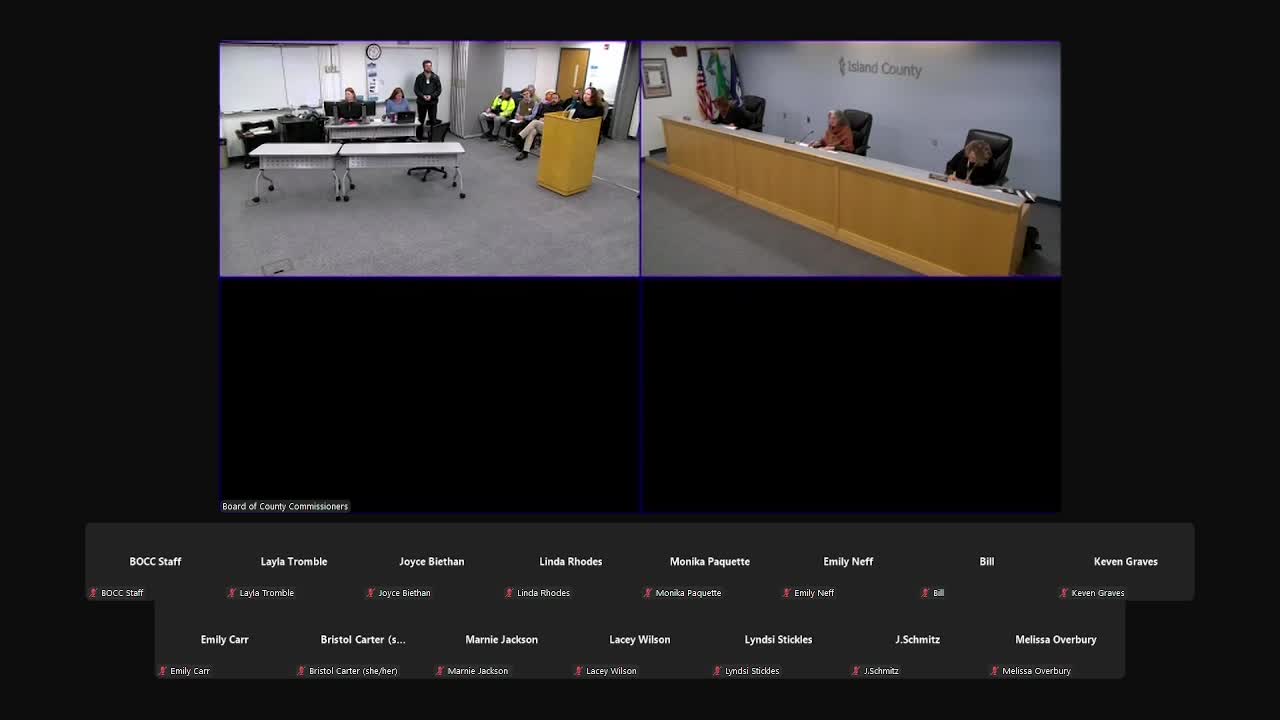Residents, Audubon groups urge stronger enforcement on shoreline armoring and groins
January 08, 2025 | Island County, Washington
This article was created by AI summarizing key points discussed. AI makes mistakes, so for full details and context, please refer to the video of the full meeting. Please report any errors so we can fix them. Report an error »

Public commenters urged Island County commissioners on Wednesday to strengthen enforcement and tracking of shoreline armoring after consultants documented recent installations and widespread noncompliance.
Jackie Lassiter, conservation chair of Whidbey Audubon, told the Board that a July 2024 boat-based mapping by Herrera Environmental Consultants found about 3 miles of new shoreline armoring installed between 2016 and 2023 and that roughly 85% of that new armor was not associated with approved permits. "The Herrera report noted that armor was present along 32.4 miles of our shoreline, which is approximately 30% of our forage fish spawning habitat," Lassiter said. She told commissioners that the findings point to substantial enforcement gaps under the Shoreline Management Act (SMA).
Joaquin Sweat, executive director of the Whidbey Audubon Society, raised specific concerns about groins — wooden or rock structures built perpendicular to the coastline — and their local effects in Useless Bay and other areas. "Groins are wooden or rock structures built perpendicular to the coastline to interrupt the flow of water and sediment," Sweat said. He said pictures he provided to staff show uneven erosion on adjacent beaches where groins block natural sediment movement and warned that poorly designed groins can accelerate erosion on the down-drift side.
Amanda Bullis of the Environmental Action Network described recent community workshops funded by the Climate Commitment Act that surfaced shoreline armoring as a recurring local concern. Bullis said the workshops aim to increase public participation in county meetings and bring more local voices into shoreline and planning discussions. "This workshop reminded me how difficult it is for some people to stand up and speak, especially if public speaking doesn't come naturally," she said.
Commissioners did not take action on shoreline policy during the meeting; some said they have not yet completed a full internal review of the Herrera report but acknowledged the public comments and indicated staff would be the conduit for follow-up. Commissioner St. Clair invited commenters to provide written follow-up so staff could connect them with the appropriate planning or enforcement personnel.
The speakers asked the Board to pursue a "more transparent and uniform system for both tracking permits in the shoreline environment and strengthening enforcement of noncompliance with the SMA," Lassiter said. The county has not announced additional enforcement steps at this meeting.
Jackie Lassiter, conservation chair of Whidbey Audubon, told the Board that a July 2024 boat-based mapping by Herrera Environmental Consultants found about 3 miles of new shoreline armoring installed between 2016 and 2023 and that roughly 85% of that new armor was not associated with approved permits. "The Herrera report noted that armor was present along 32.4 miles of our shoreline, which is approximately 30% of our forage fish spawning habitat," Lassiter said. She told commissioners that the findings point to substantial enforcement gaps under the Shoreline Management Act (SMA).
Joaquin Sweat, executive director of the Whidbey Audubon Society, raised specific concerns about groins — wooden or rock structures built perpendicular to the coastline — and their local effects in Useless Bay and other areas. "Groins are wooden or rock structures built perpendicular to the coastline to interrupt the flow of water and sediment," Sweat said. He said pictures he provided to staff show uneven erosion on adjacent beaches where groins block natural sediment movement and warned that poorly designed groins can accelerate erosion on the down-drift side.
Amanda Bullis of the Environmental Action Network described recent community workshops funded by the Climate Commitment Act that surfaced shoreline armoring as a recurring local concern. Bullis said the workshops aim to increase public participation in county meetings and bring more local voices into shoreline and planning discussions. "This workshop reminded me how difficult it is for some people to stand up and speak, especially if public speaking doesn't come naturally," she said.
Commissioners did not take action on shoreline policy during the meeting; some said they have not yet completed a full internal review of the Herrera report but acknowledged the public comments and indicated staff would be the conduit for follow-up. Commissioner St. Clair invited commenters to provide written follow-up so staff could connect them with the appropriate planning or enforcement personnel.
The speakers asked the Board to pursue a "more transparent and uniform system for both tracking permits in the shoreline environment and strengthening enforcement of noncompliance with the SMA," Lassiter said. The county has not announced additional enforcement steps at this meeting.
View full meeting
This article is based on a recent meeting—watch the full video and explore the complete transcript for deeper insights into the discussion.
View full meeting
